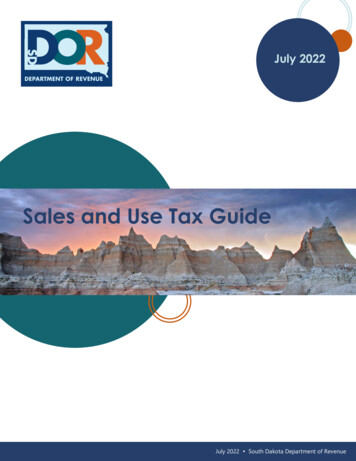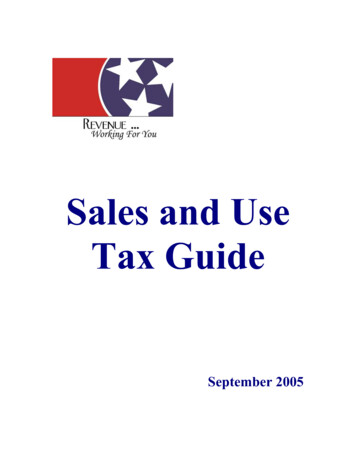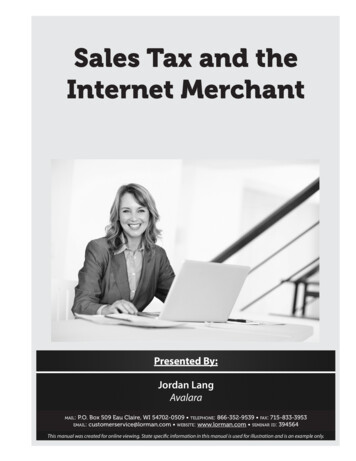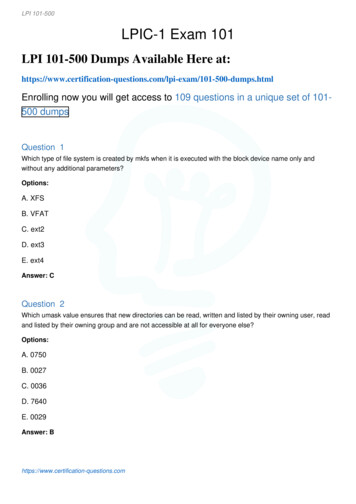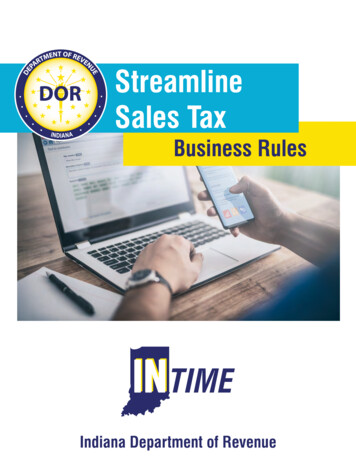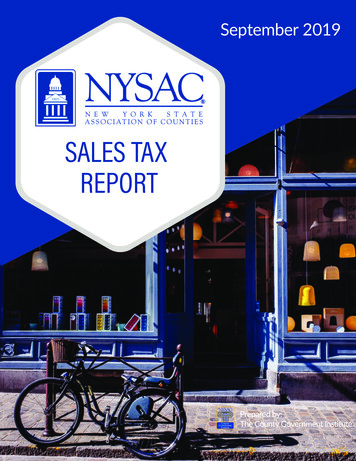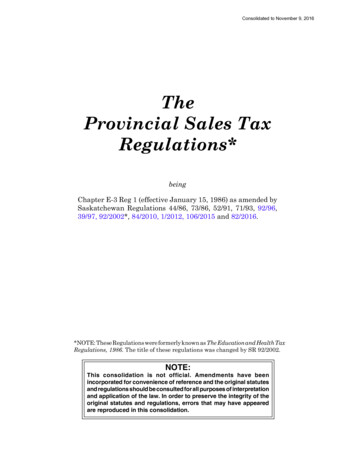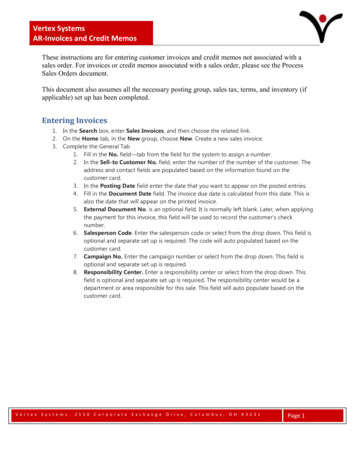
Transcription
Navigating Sales Tax Treatment of Direct Mailand Online Promotional CommunicationsTUESDAY, MAY 5, 2015, 1:00-2:50 pm EasternIMPORTANT INFORMATIONThis program is approved for 2 CPE credit hours. To earn credit you must: Attendees must stay connected throughout the program, including the Q & A session, in order to qualify for fullcontinuing education credits. Strafford is required to monitor attendance. Listen on-line via your computer speakers. Record verification codes presented throughout the seminar. If you have not printed out the “Official Record ofAttendance,” please print it now (see “Handouts” tab in “Conference Materials” box on left-hand side of your computerscreen). To earn Continuing Education credits, you must write down the verification codes in the corresponding spaces foundon the Official Record of Attendance form. Please refer to the instructions emailed to the registrant for additional information. If you have any questions, pleasecontact Customer Service at 1-800-926-7926 ext. 10.WHOM TO CONTACTFor Assistance During the Program:-On the web, use the chat box at the bottom left of the screenIf you get disconnected during the program, you can simply log in using your original instructions and PIN.
Tips for Optimal QualityFOR LIVE EVENT ONLYSound QualityWhen listening via your computer speakers, please note that the qualityof your sound will vary depending on the speed and quality of your internetconnection.If the sound quality is not satisfactory, please e-mail sound@straffordpub.comimmediately so we can address the problem.Viewing QualityTo maximize your screen, press the F11 key on your keyboard. To exit full screen,press the F11 key again.
Program MaterialsFOR LIVE EVENT ONLYIf you have not printed the conference materials for this program, pleasecomplete the following steps: Click on the symbol next to “Conference Materials” in the middle of the lefthand column on your screen. Click on the tab labeled “Handouts” that appears, and there you will see aPDF of the slides and the Official Record of Attendance for today's program. Double-click on the PDF and a separate page will open. Print the slides by clicking on the printer icon.
Navigating Sales Tax Treatment ofDirect Mail and Online PromotionalCommunicationsMay 5, 2015Martin I. Eisenstein, Brann & Isaacsonmeisenstein@brannlaw.comMatthew P. Schaefer, Brann & Isaacsonmschaefer@brannlaw.com4
Today’s ProgramEssential Concepts with Respect to Taxability of Direct Mailand Electronic Communications[Matthew Schaefer]Slide 7 – Slide 20Latest State Actions[Matthew Schaefer]Slide 31 – Slide 39Examples of Specific State Laws and Tax Policies[Martin Eisenstein]Slide 40 – Slide 50Nexus-Related Issues[Martin Eisenstein]Slide 51 – Slide 76Taxability of Postage and Shipping[Martin Eisenstein]Slide 77 – Slide 835
NoticeANY TAX ADVICE IN THIS COMMUNICATION IS NOT INTENDED OR WRITTEN BYTHE SPEAKERS’ FIRMS TO BE USED, AND CANNOT BE USED, BY A CLIENT OR ANYOTHER PERSON OR ENTITY FOR THE PURPOSE OF (i) AVOIDING PENALTIES THATMAY BE IMPOSED ON ANY TAXPAYER OR (ii) PROMOTING, MARKETING ORRECOMMENDING TO ANOTHER PARTY ANY MATTERS ADDRESSED HEREIN.You (and your employees, representatives, or agents) may disclose to any and all persons,without limitation, the tax treatment or tax structure, or both, of any transactiondescribed in the associated materials we provide to you, including, but not limited to,any tax opinions, memoranda, or other tax analyses contained in those materials.The information contained herein is of a general nature and based on authorities that aresubject to change. Applicability of the information to specific situations should bedetermined through consultation with your tax adviser.6
Matthew P. Schaefer, Brann & IsaacsonESSENTIAL CONCEPTS WITHRESPECT TO TAXABILITY OFDIRECT MAIL ANDELECTRONICCOMMUNICATIONS7
How Do States Define “Direct Mail”? Streamlined Sales and Use Tax Agreement (SSUTA) definition: Direct mail means printed material delivered or distributed by U.S. mail orother delivery service to a mass audience or to addressees on a mailing listprovided by the purchaser or at the direction of the purchaser, when thecost of the items are not billed directly to the recipients. “Direct mail”includes tangible personal property supplied directly or indirectly by thepurchaser to the direct mail seller for inclusion in the package containingthe printed material. “Direct mail” does not include multiple items ofprinted material delivered to a single address (underlining added). Applicable in nearly 25 states.8
How Do States Define “Direct Mail”? (cont.) Other states define a broader category of materials (e.g.“promotional materials”) or a narrower subset (e.g.“cooperative” direct mail) for particular tax treatment. Some states have no specific definition and treat direct maillargely like other tangible personal property. Some states treat direct mail as theproduct of printing services and imposetax on “printed materials.”9
Greater Regulatory Focus On PromotionalDirect Mail SSUTA subcategories “Advertising and Promotional Direct Mail”: “Other Direct Mail”: Printed material that meets the SSUTA definition of directmail, the primary purpose of which is to attract publicattention to a product, person, business or organization, orto attempt to sell, popularize or secure financial supportfor a product [or service], person, business ororganization.Any direct mail that is not “advertising and promotionaldirect mail” regardless of whether “advertising andpromotional direct mail” is included in the same mailing.Several non-SSUTA states have specific treatmentfor promotional direct mail.10
What Is The SSUTA? A multi-state compact among participating states, each of whichmust substantially conform its laws to the terms of the Agreement. “It is the purpose of this Agreement to simplify and modernizesales and use tax administration in the member states in order tosubstantially reduce the burden of tax compliance.” Twenty-four member states.― Arkansas, Georgia, Indiana, Iowa, Kansas, Kentucky, Michigan, Minnesota,Nebraska, Nevada, New Jersey, North Carolina, North Dakota, Ohio, Oklahoma,Rhode Island, South Dakota, Tennessee, Utah, Vermont, Washington, WestVirginia, Wisconsin, Wyoming (but Tennessee not yet in full compliance).Conformity legislation has been introduced in other states, but nonew member has been added since 2011. Proposed federal salestax legislation appears to have dampened interest among states.11
Examples Of Types Of Direct Mail Materials These items are generally considered to be advertising/promotional directmail, although some may be excluded in certain jurisdictions: Mail order catalogsFlyers/brochuresAdvertising circulars/newspaper insertsCoupons (sometimes “cooperative” direct mail)Advertising folders, envelopesThese items are generally not considered to be advertising/promotionaldirect mail, but some may qualify in certain jurisdictions: Non-printed advertising materials such as video tapes, computer disks, refrigerator magnets,etc. (unless they fall within a state’s definition of promotional materials)Billing invoices/account statementsStockholder reportsLegally required mailingsPrivacy notices12
Overview Of Taxability Of Direct Mail As “tangible personal property,” direct mail is presumptivelysubject to state and local use tax, unless an exemptionapplies. A number of large states have exemptions for some types of direct mail(e.g., CA, NY, PA, OH, IL, VA). Most SSUTA member states subject direct mail to tax (with exceptionsfor specific types in OH, OK, RI, WI, WY and MI (per prior case law)).In some cases, the purchase of services associated with theproduction or delivery of direct mail may not be taxable (e.g.,advertising or letter shop services), but often such servicesare considered part of the taxable “sales price.”13
Overview Of Taxability OfElectronic Communications Delivering the same content, to the same recipients, but via electronic means, willfundamentally alter its tax treatment in most jurisdictions. Communications delivered electronically are no longer considered tangiblepersonal property in most states (with some exceptions), eliminating thepresumption of taxability. See, e.g., Missouri DOR LR 7407 (Mar. 7, 2012). Electronically delivered communications do not meet the definition of “directmail” under the SSUTA or the laws of most states because they are no longerprinted materials. SSUTA specifically requires states to comment on the taxability of “productstransferred electronically” (separate from digital audio and audiovisualproducts and books). See SSUTA State Taxability Matrices, Ref. No. 31000. For non-SSUTA states that do not treat electronic communications as TPP,they must be evaluated against the categories of taxable services in eachstate.14
Overview Of Taxability OfElectronic Communications Electronic communications are potentially taxable under avariety of different tax treatments, depending upon thenature/characteristics of the communications. State may follow the taxability of a comparableproduct in tangible form (e.g., CO, ME, TX, UT). Electronic delivery may be taxable as “data processingservices.” States with a tax on data processingservices include CT, DC, OH, TX. State tax on “information services” may apply,depending upon the source and content of thecommunication (e.g., NJ, NY, OH). Some states tax receipts from all goods and services,absent a specific exemption (HI, NM, SD, WV). A very broad state “communications” tax maypotentially apply (e.g., SC).15
Delivery Charges For Direct Mail As a percentage of the total cost of a transaction,shipping/transportation/postage is typically much higher fordirect mail than for other products (such as consumer goods). Many states exclude separately stated delivery charges fromthe sales price for purposes of calculating sales and use tax. Some states exclude postage but not shipping (e.g., NE, SD,TX). The SSUTA permits its members to havespecial rules for the tax treatment ofdelivery charges for direct mail.16
Delivery Charges For Direct Mail (cont.) Under the SSUTA, unless delivery charges are statedseparately on the invoice, they are not eligible forexclusion from sales tax. If delivery charges are stated separately, SSUTA memberstates can choose whether to exclude them from sales tax,or to exclude specific aspects of delivery charges:―Handling, crating, packing, preparation for mailing ordelivery, and similar charges.―Transportation, shipping, and similar charges.―Postage.17
Exemptions Available By Statute, As Well AsUnder Court And Administrative Decisions Statutory exemptions:―California “printed sales messages” exemption (Cal. Rev. & Tax. Code §6379.5; Cal. Code Regs. § 1541.5).―New York “promotional materials” exemption (NY Tax Law § 1115(n)(4)).―Massachusetts “direct and cooperative direct mail promotional advertisingmaterials” exemption (Mass. Gen. L. ch. 64H, § 6(ff)).Exemptions by court decision or administrative ruling for materialsdelivered from outside the state by US Mail:―Michigan (Sharper Image Corp. v. Department of Treasury, 550 N.W.2d 596(Mich. App. 1996)).―Illinois (see Ill. Department of Revenue, General Information Letter ST 010003-GIL (Jan. 5, 2000)).―Virginia (see Ruling of Virginia Tax Commissioner, P.D. 97-61 (Feb. 10.1997)).18
Typical Tax Issues For Purchasers Is my company subject to a sales/use tax obligation in the state(s) intowhich we are mailing? Does the printer charge tax, where applicable? Do my direct mail materials qualify for an exemption in any relevantjurisdictions? What is the correct exemption certificate to issue the printer? How might SSUTA default rules affect my business? What otherdocumentation should I provide the printer? Is postage/shipping exempt and if so, in which jurisdictions? Will my company’s IT system properly accrue the correct use tax, whereapplicable, if the printer does not charge the appropriate tax? Are there storage issues with direct mail advertising literature or materials?19
Typical Tax Issues For Printers Is my company required to collect the state’s sales/usetax? Have we obtained a direct pay, direct mail, or exemptioncertificate from the purchaser? Does my company have nexus in the state? Does the purchaser have nexus? Does the mailing list received from my customercontain the information needed to comply with stateor SSUTA sourcing rules? Does my billing system have the ability to charge theappropriate tax for each jurisdiction? Are there storage issues with direct mail materials?20
Sourcing Issues What state’s (and possibly locality’s) law applies todetermine if tax is due? Which party — the seller or the purchaser — bears theresponsibility for determining and collecting / reportingthe applicable tax?21
Sourcing Issues: Taxability The majority rule is “destination” sourcing, i.e., thesales/use tax is determined under the law of thejurisdiction where the tangible materials are ultimatelydelivered. For example, the SSUTA generally provides for“destination” sourcing (Sections 310, 313), but . The SSUTA permits “origin” sourcing, under whichthe sales/use tax is determined based on the pointof sale, for intrastate sales (see SSUTA, Section313.1), although this has been adopted so far byonly two member states (UT, WA). To complicate matters, a “use” might occur in astate even when the sales transaction does not.22
Sourcing Issues: Taxability (cont.) In addition, several non-SSUTA states (e.g., AZ, CA, IL, PA, TX) have ageneral rule that calls for “origin” sourcing, however: such “origin” sourcing rules may apply only to intrastatetransactions/deliveries; and in the case of interstate sales, including the delivery of directmail to other states, such rules are typically superseded byexpress exemptions, rules, or enforcement practices thatacknowledge underlying constitutional principles applicable tointerstate commerce (and thus result in destination sourcingbased on the “use” of direct mail in the state(s) where it isdelivered).23
Sourcing Issues: Taxability (cont.) The structure of a direct mail transaction may create challenges indetermining what state’s law applies. If a printer does not also arrange for mailing to end user recipients, butinstead delivers in bulk to a purchaser or letter shop to complete the mailing,the purchase of direct mail may be viewed as a bulk sale and aspects of taxtreatment may change, such as exemptions, sourcing and even tax on postage. If a printer lacks sufficient information to allocate and source a sale of directmail based on the delivery location(s), the printer may be required to collectsales tax under a default assumption. The SSUTA requires the printer to source to the shipping location foradvertising and promotional direct mail, and to the address of thepurchaser for “other” direct mail. (SSUTA, Section 313.A.4, B.1.) Non-SSUTA states may vary, creating challenges for the printer.24
Sourcing Issues: Who Must Report? Typically, a seller must determine sourcing and collect anyapplicable sales/use tax. (Note: The purchaser is onlyrelieved of the obligation if the seller collects.) Because direct mail is delivered to multiple jurisdictions, as towhich the seller may have insufficient information for taxpurposes, direct mail can present difficulties for the seller. The SSUTA, and some non-SSUTA states, offer procedures orexemptions that place sourcing and reporting burdens on thepurchaser. Either way, local sourcing/taxes make reporting a challenge.25
Sourcing Issues: WhoMust Report? (cont.) Under the SSUTA and the laws of some other states (e.g., TX), aseller is relieved of the obligation to collect tax where thepurchaser provides a direct pay permit or a “direct mail certificate”indicating that the purchaser will report tax. See SSUTA, Section313.A.2, B.2. Some states provide express exemptions from tax for direct mailmaterials delivered to locations outside the state. (Such exemptionsdo not mean that the destination state’s tax is inapplicable,however.) The issue may be complicated where a purchaser lacks nexus in thedestination state(s).26
Sourcing Issues: Double Taxation? Conflicting sourcing rules can lead to cases where more than onejurisdiction has a claim to some portion, or even all, of a mailing ofprinted materials. In many cases, such conflicts are resolved, atleast in part, by credit provisions in state taxlaws designed to avoid double taxation. But state provisions are often premised on a creditagainst the use tax for sales tax already paid. Directmail may involve two states each claiming the sale. Which prevails? A taxpayer typically gets credit only to the extent tax was paid to anotherjurisdiction, so a state with a higher tax rate may seek the difference.27
Sourcing Issues: Double Taxation? SSUTA default rules present a significant risk of double taxation. For promotional direct mail, the SSUTA default rule is the locationfrom which the materials were sent (Section 313.A.4). Non-SSUTA, destination sourcing states may seek tax on some portion. SSUTA provides that member states may disallow credits if default applies.For “other direct mail,” SSUTA default rule is the purchaser’sbusiness address (Section 313.B.1). Applies whenever purchaser fails to give direct pay permit or direct mailcertificate, even when purchaser gives shipping information. If the printer has nexus in both the purchaser’s home state and one or moredestination states to which mail is delivered, the printer would be subject totax collection and remittance obligations in two or more jurisdictions.28
Sourcing Issues: Electronic Delivery How electronic delivery is sourced will depend on the basis of its taxability: Areelectronically delivered materials the equivalent of TPP, or taxable as a service? If treated as TPP: Direct mail sourcing rules in SSUTA states would no longer apply, becauseelectronically delivered materials are not “direct mail.” The majority rule for TPP is destination sourcing, though SSUTA states have acascading set of default rules. Do you know the destination state of electronically delivered materials?If treated as a service: May be the place where the “(benefit of the) service is received.” May be the location at which the service is provided.29
Slide Intentionally Left Blank
Matthew P. Schaefer, Brann & IsaacsonLATEST STATE ACTIONS31
Valpak of Omaha LLC v. Dept. of Revenue(Neb. Supreme Ct. Mar. 27, 2105) A seller of cooperative direct mail advertising is subject to usetax on payments made to a printer of advertising materials. Appellant Valpak of Omaha (“Valpak Omaha”) was a franchisee of thenational cooperative direct mail firm, Val-pak Direct Marketing Systems,Inc. (“VDM”), a Florida corporation. Valpak Omaha solicited advertisements from local businesses forinclusion in a package to be delivered to targeted groups of localconsumers via direct mail. Valpak Omaha contracted with VDM to printand send the cooperative direct mail packages directly to consumers. Valpak Omaha neither collected tax on its charges to customers nor paidtax on its purchases from VDM. The Nebraska DOR assessed Valpak 417,000 in unpaid use tax on payments to VDM over a five-year period.32
Valpak of Omaha LLC v. Dept. of Revenue(cont.) Backstory: A prior licensee of VDM had lost a use tax challengein 1996 on similar payments, on grounds that the licensee: Was an “advertising agency” under DOR rules; Was the consumer of the goods and servicesit purchased from VDM. Taxpayer may have been optimistic it couldtake advantage of a victory by another VDM franchisee inVal-Pak East Valley, Inc. v. Arizona Dept. of Revenue, 229 Ariz.164 (Ct. App. 2012). Arizona Court found no taxable use of printed materials in thestate by VDM franchisee.33
Valpak of Omaha LLC v. Dept. of Revenue(cont.) Valpak Omaha secured a stipulation from the Nebraska DOR that salestax did not apply to its charges to its customers, setting up questionof whether Valpak Omaha was subject to Nebraska use tax — but tono avail. Instead of addressing the case as turning on the use of the printedmaterials, the Nebraska Supreme Court held that Valpak was liablefor tax as an advertising agency on its purchases of labor (i.e.,services) from VDM, while glossing over certain tricky questions. Lesson: The complexities of applying sales and use tax principles todirect mail often allow for a variety of different rationales indetermining tax treatment. Such complexities require considerablecare from sellers and purchasers of direct mail.34
Virginia Ruling PD 14-14: ElectronicCommunications Are Exempt Virginia Tax Commissioner was asked by a provider of printing, directmail, and electronic document services to review an assessment ofsales tax on electronic document services provided over the Internet. Three different electronic communication services were involved: eView/eApprove – A service that allows customers to view onlinedocuments such as bank statements. DocSight – A service that permits third-parties to view electronic versionsof a document through a website. PDF Image Transfer – The electronic transfer of documents in a PDFformat.The auditor found that the electronic document services were billedin connection with sales of printed materials and thus subject to tax.35
Virginia Ruling PD 14-14: ElectronicCommunications Are Exempt (cont.) The Tax Commissioner found each of the services to be exempt from tax. Virginia Code section 58.1-609.5 includes an exemption for “services notinvolving an exchange of tangible personal property which provide access to oruse of the Internet and any other related electronic communication service,including software, data, content and other information service deliveredelectronically via the Internet.” The Tax Commissioner also agreed with the taxpayer that, although they werebilled on the same invoice, the electronic document services were entirelyseparate from the sales of printed materials. Finding the exemption to apply, the Tax Commissioner eliminated the tax.Proper outcome, but the Commissioner’s reasoning is of concern because he reliedupon the exemption, rather than the fact that the separate electronic documentservices were not properly within the scope of taxable TPP.36
Recent Rulings Remind Us That ForSales Tax, The Devil Is In The Details Electronic communications: South Carolina Department of RevenuePrivate Letter Ruling #14-5 (Dec. 10, 2014). South Carolina taxes “communications” (as TPP) but excludes “data processing.” Taxpayer offered a non-taxable service in which it complied and manipulatedclaims data for insurers, and gave clients remote access to the data. DOR noted that merely providing access to data electronically, withoutmanipulating/processing the data, would be taxable. Promotional direct mail: Indiana Department ofRevenue Letter Ruling 04-21040079 (Aug. 27, 2014). Purchaser of printed promotional materials paid singleprice, with no components separately stated. Department sustained the tax despite a letter from theprinter attesting that the price included non-taxable postage and even taxes.37
Expanded Catalog Exemption In Wisconsin Wis. Stat. § 77.54(59) (2013) expanded the exemption forpromotional materials to exclude from sales and use tax “[t]he salesprice from the sale of and the storage, use, or other consumption ofadvertising and promotional direct mail [as defined in the SSUTA.]” Regulations published by the Wisconsin Department of Revenueprovide that the exemption includes any charges for the deliveryof advertising and promotional direct mail, as well. (See Wis.Reg. Tax 11.70, 11.94) Note that other Wisconsin statutory provisions (Wis. Stat.§ 77.54(15), § 77.54(25m)) exempt specific categories of directmail materials, including, in particular, catalogs.38
Recent State Laws And LegislationRegarding Tax Treatment Of Direct Mail Maine adopts exemption for free publications, including promotionalmaterials included in the publication (36 M.R.S.A. sec. 1760(14-A)): Any “publication” purchased for distribution without charge is exempt. “Publication” means printed paper material such as newspapers, magazinesand trade journals issued at intervals not exceeding 3 months. “Publications” do not include materials consisting primarily of advertisementsor the promotion of a single seller’s products or services.Exemption extends to printed promotional materials for inclusion in thepublication. Affidavit form verifies the exemption. Form ST-A-125.SSUTA Member states continue to clarify/adjust their laws: With regard to direct mail sourcing and default rules (OH, NV, NC, TN). With regard to postage and/or shipping (GA, NE, WA).Florida bill to watch: SB 858 (2015), if passed, would fully exempt“direct mail advertising literature.”39
Martin I. Eisenstein, Brann & IsaacsonEXAMPLES OF SPECIFIC STATELAWS AND TAX POLICIES40
Examples Of Specific State Laws:Pennsylvania Statute (72 P.S. §7204(35)) exempts: Catalogs and advertising literature or materials, which aredefined as tangible personal property that is intended topromote a business interest, create goodwill or engage theattention or interest of a recipient, and includes envelopes,address labels, application forms and mailing charges (Reg.Sections 31.29 and 32.36) Annual corporate and financial reports and financialprospectuses are exempt but proxy materials and otherpublications are taxable Advertising inserts as part of a newspaper One-time use of a list of names (list rental) and mailingaddresses41
Examples Of Specific State Laws:Pennsylvania (cont). Key requirement: Distributed through the U.S. Postal Service. Will be deemed taxable if distributed by other means. Key exclusion from exemption: If the advertiser supplies the paper, printing charges aresubject to sales tax and direct advertising exemptiondoes not apply, because printing services are deemedtaxable (Reg §32.36). Unclear whether printing on advertiser-supplied paperoutside of Pennsylvania is subject to use tax.Note: No requirement that advertiser be the mailer. MerionPublications, Inc. v. Commonwealth, 890 A.2d 436(Commonwealth Court 2006).42
Examples Of Specific State Laws: Florida Statute (Fla. Stat. §212.08(7)(w)) exempts: Free Circulated publications Published on a regular basis Composed of primarily advertising Distributed through the mail, homedelivery or newsstand.Department strictly construes exemption.43
Examples Of Specific State Laws:Florida (cont.) Catalogs and other direct advertising materialsarguably fit within this definition. The biggest issue regarding promotional materials isshowing that they are "published on a regular basis." Department argues that catalogs distributed ondifferent days in a month, from year to year,may not meet the regularity requirement.Electronic Communications Not taxable in FL even though FL taxesinformation services. See Rule 12A-1.062(5).44
Examples Of Specific State Laws: Ohio Statute exempts sales for which: (1) The “purpose” of the consumer is to use or consume thethings transferred in making retail sales; and (2) The itemsare newspaper inserts, catalogs, coupons, flyers, giftcertificates or other advertising material that prices anddescribes tangible personal property offered for retailsale. (Rev. Code Ann. Sec. 5739.02(B)(35)). Also exempts printed matter that offers free merchandiseor chances to win a sweepstakes, if mailed to potentialcustomers with materials described in the first bullet.45
Examples Of Specific State Laws: Ohio (cont.) Sales of preliminary materials to direct marketers that are usedin printing are also exempt (photographs, artwork, pre-press). Ohio statute is silent on mailing lists. Distribution by taxpayer to retail stores of store displays doesnot satisfy the requirement that the consumer use the materialstransferred in making retail sales. Opinion of Tax Commissioner94-004. Catalogs distributed by salesman are exempt per CurtisIndustries, BTA 1964. Suggests requirements that materials be distributed byadvertiser to prospective customers for ordering, but alsoarguably because of function of catalogs.46
Examples Of Specific State Laws:New York Tax Law Sec. 1115(n)(4) Three Elements of Exemption. Element 1: Printed promotional materials and promotionalmaterials upon which services are performed. Broad definition includes advertising material, relatedtangible personal property (e.g. free gifts,complimentary maps, applications, order forms andreturn envelopes), raw materials and envelopes usedexclusively for delivering materials. Exempt are mailing lists, including merge purgeservices, for promotional materials. Exempt are shipping and handling charges. Does not include invoices, statements, or similar items.47
Examples Of Specific State Laws:New York Tax Law Sec. 1115(n)(4) (cont.) Element 2: Shipment by purchaser by mail orcommon carrier. Element 3: Without charge to the purchaser’scustomers. Does not include shipment by printer’s trucks.TSB-A-13(16)S; TB-ST-692 (2014).Membership fee that includes rights tomaterials is a charge. TSB-A-13(16)S.Purchaser must use Form ST-121.2. Is not a concession of nexus by the purchaser.48
Examples Of Specific State Laws:New York Information Services NYS §1105(c)(1) and (c)(9) tax information services, both on printedand electronic media. Information services are defined as furnishing of information,including the services of collecting, compiling or analyzinginformation and furnishing reports thereof to other persons, butexcluding: Furnishing information that is personal or individual in natureand not substantially incorporated in reports to other persons. Advertising services, which are defined as placement ofadvertisements with the media. Note: An Internet service that enables its customers tocapture, display and
How Do States Define "Direct Mail"? Streamlined Sales and Use Tax Agreement (SSUTA) definition: Direct mail means printed material delivered or distributed by U.S. mail or other delivery service to a mass audience or to addressees on a mailing list provided by the purchaser or at the direction of the purchaser, when the
